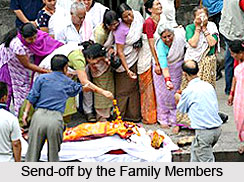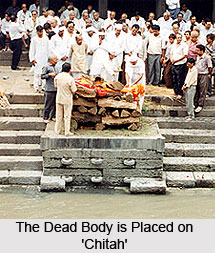 Hindus cremate the body after death because they believe that physical body is no more in need but the soul is important. According to Hindu religious belief our body is made up of natural elements like earth, water, air, fire and the God of fire carries these elements to their respective sources at death. The holy fire or Agni is the purifying agent that enables the soul to be liberated from the physical body.
Hindus cremate the body after death because they believe that physical body is no more in need but the soul is important. According to Hindu religious belief our body is made up of natural elements like earth, water, air, fire and the God of fire carries these elements to their respective sources at death. The holy fire or Agni is the purifying agent that enables the soul to be liberated from the physical body.
Hindus also believe that death generates negative attitudes like sorrow, grief or mourning among the relatives of the deceased. The mourners are instructed to stay at home so that the negative attitudes do not spread among the others and they are compelled to do so until the Shradh is done.
The Anteshti Kriya is a ceremony to give a send-off to the soul of the bygone by the family members. It is said that the soul remains in the vicinity of the death body until the Anteshti Kriya is not completed.
Usually the body is cremated within six hours of the very day the death occurs. However if it is not possible then it is done, as early as possible and in most cases it is never kept longer than a day.
Before the cremation or Anteshthi Kriya the body is brought home, washed, clothed, garlanded and laid on its back on the floor. The head of the body is positioned towards south as south is considered the region of the Yama, the Death God. A lamp is lit and placed towards the head of the dead body, which is not to be extinguished until the body is cremated. Someone touches the body and keeps vigil until the time of cremation. Finally the body is carried to the place of cremation in a procession of the mourners.
Relatives and friends pay their last homage to the expired person by walking round the body and placing flowers or garland on the body. They offer their condolence by touching the hands of grieving family members. At this grave and sad moment no food is prepared and served in the bygone`s family.
 At the Anteshti Kriya a priest generally directs all the rituals. Where a priest is not available, a knowledgeable elder from the community gives guidance. The eldest son of the decease performs all the ceremony. If eldest son is absent other sons can do the Anteshti Kriya and in cases where there is no son in the family, an elder male relative performs the ceremony.
At the Anteshti Kriya a priest generally directs all the rituals. Where a priest is not available, a knowledgeable elder from the community gives guidance. The eldest son of the decease performs all the ceremony. If eldest son is absent other sons can do the Anteshti Kriya and in cases where there is no son in the family, an elder male relative performs the ceremony.
The body is placed on `Chitah` or bed of woods with its head pointing south. The eldest son carries a pot of water on his left shoulder, using his right hand to hold the pot in place. He circumambulates or goes around the body three times in an anti-clockwise direction, from left to right. The younger sons follow behind him.
The priest makes a hole in the pot each time the eldest son circumambulates the body to allow the water to flow out of the pot. Water is considered as the purifying agent. As the eldest son moves, he swings his left hand to the side to disperse the water flowing from the pot. It is believed that in the first circumambulation, the water that flows helps the soul to depart from the terrestrial world; during the second one the water flows to purify the atmosphere and in the third one water leads the soul to heaven. After the third and final circumambulation is complete, the son faces north and throws the pot over his shoulder to the south. He turns towards right and picks up a piece of broken pot that contains water. He then pours the water in the mouth of the body, which is the last action of purification.
There is a pot of fire, which is brought from home, kept at the foot of the body. The eldest son takes a piece of cinder or a twig and lights it with the fire from the pot. He walks in a clockwise direction, places the burning twig or cinder on the chest and bends facing south where Yama is thought to be present. The younger sons walk off first, followed by the eldest son who walks off last.
There are variations to the rituals described above though more or less same procedures is followed everywhere. Prayers and hymns from the holy Hindu scriptures like Bhagavad Gita are recited while the body burns. They express the belief of rebirth : "For to one that one is born, death is certain; and to one that dies, birth is certain. Therefore do not grieve over what is unavoidable."
After the body is completely burnt the eldest son returns to pick the bones and collect the ashes which are then put in a earthen pot. The pot is then placed into a flowing river from where it cannot return to the land. The mourning period starts after the Anteshti Kriya and it lasts upto ten, fifteen days or a year from the death following Hindu almanac.




















